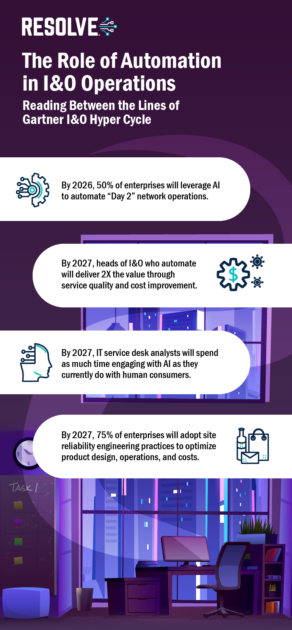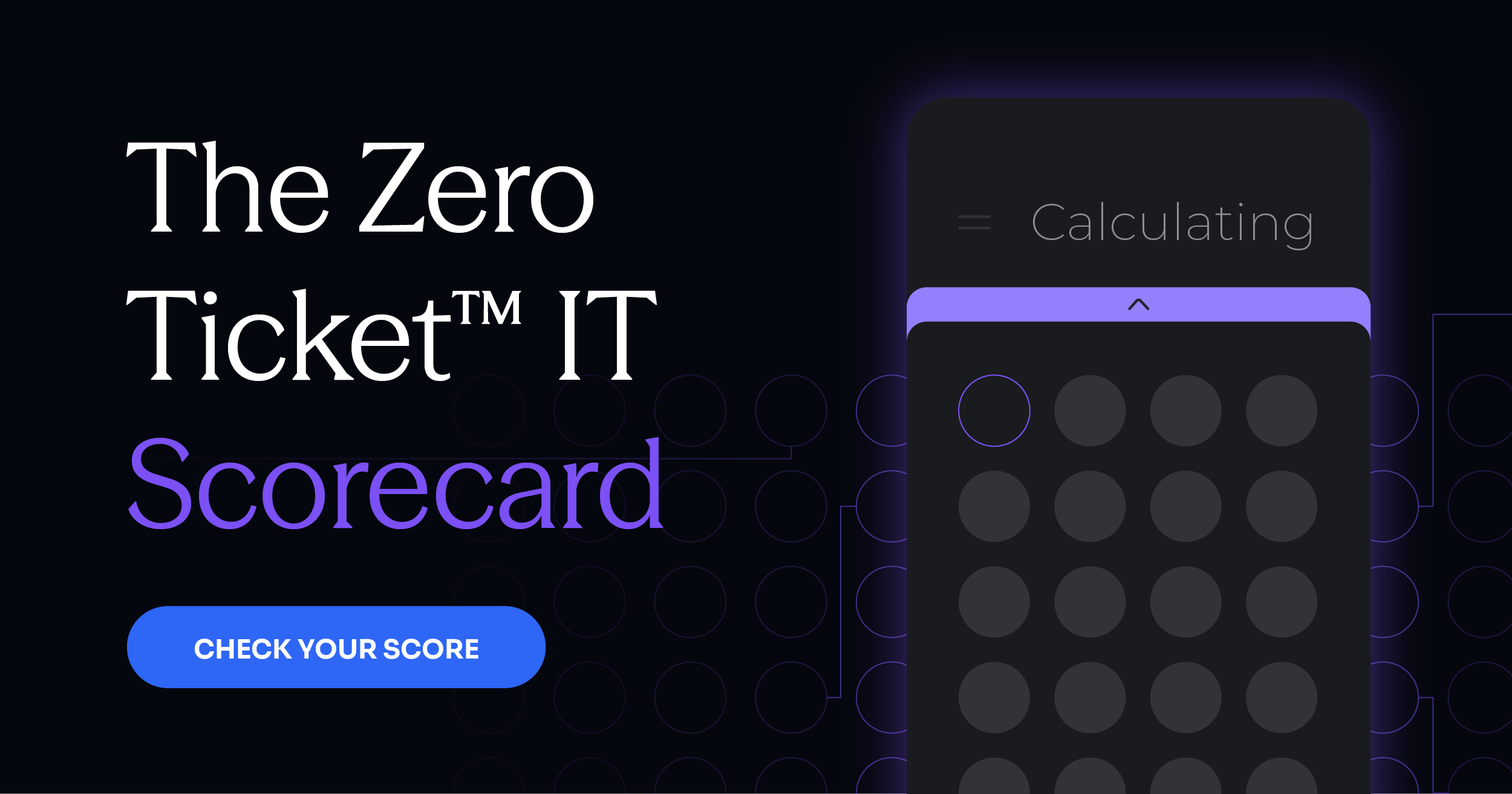
Harnessing the Power of Automation: Key Insights from the 2024 Hype Cycle for I&O
Subscribe to receive the latest content and invites to your inbox.
Automation has emerged as a key enabler of efficiency, agility, and value creation for Infrastructure and Operations (I&O). As enterprises grapple with increasingly complex IT environments, automation is no longer a luxury but rather a fundamental necessity.
The 2024 Hype Cycle for I&O Automation highlights the trends, innovations, and predictions that will shape the future of IT operations. For I&O leaders looking to streamline operations, reduce costs, and drive innovation, understanding and leveraging these automation trends is critical.
This article will dive into the Gartner Hype Cycle model, its relevance to I&O, and the automation technologies that are poised to transform the landscape by 2027. We'll also explore how organizations can strategically adopt automation tools to improve service delivery, optimize infrastructure, and upskill their workforce.
What is the Hype Cycle?
The Gartner Hype Cycle is a visual representation used to track the maturity and adoption of emerging technologies. Each technology follows a predictable path through various phases:
- Hype Cycles offer a glimpse into the current stage of market adoption, maturity, and the value of innovations within specific sectors, such as technology or business domains.
- Most innovations—whether in technologies, services, or methodologies—typically follow a journey of initial enthusiasm, subsequent disillusionment, and eventual widespread adoption and productivity.
- Both Hype Cycles and Priority Matrices enable CIOs and IT leaders to more effectively evaluate innovations by considering such factors as their perceived value, business implications, adoption rates, and future potential.
For I&O leaders, the Hype Cycle serves as a roadmap for assessing where a technology stands in terms of market adoption and maturity. It helps decision-makers understand whether a technology is overhyped, entering its productive phase, or still in its infancy, thereby informing strategic decisions about when to invest.
I&O Automation: Key Predictions and Trends
The Hype Cycle for 2024 includes several forward-looking predictions that highlight the increasing role of automation in I&O operations. Among the standout predictions:
- AI-Driven Network Operations by 2026
By 2026, Gartner predicts that 50% of enterprises will leverage AI to automate "Day 2" network operations. These are the ongoing, repetitive tasks needed to maintain network performance after deployment, such as monitoring, patching, and troubleshooting. In 2023, less than 10% of enterprises utilized AI for these operations. This significant shift will enable organizations to reduce manual intervention, minimize downtime, and ensure operational resilience. - Doubling of Automation-Driven Value by 2027
By 2027, heads of I&O who prioritize automation will double the value they deliver through service quality and cost improvements. Automation not only accelerates service delivery but also enhances service consistency and reliability, leading to enhanced customer satisfaction and improved operational efficiency. - AI in IT Service Desks
AI is poised to play a larger role in IT service desks. Specifically, by 2027, IT service desk analysts will spend as much time engaging with AI as they currently do with business consumers. The rise of AI-powered chatbots and virtual assistants will help streamline support workflows, reduce resolution times, and free up human analysts to focus on more complex tasks. - Organization-Wide Adoption of Site Reliability Engineering (SRE)
Gartner predicts that by 2027, 75% of enterprises will adopt site reliability engineering (SRE) practices to optimize product design, operations, and costs. This is a monumental increase from the 10% adoption rate in 2022. SRE practices focus on creating automated systems that ensure reliability and scalability, making them a natural fit for organizations aiming to meet ever-growing customer demands.

How These Predictions Should Shape Your Automation Strategy
For I&O leaders, automation is the catalyst for delivering business value at speed and scale. As the predictions above suggest, automation is becoming more pervasive across all aspects of IT operations. To remain competitive, I&O leaders must consider the following factors when developing their automation strategy
- Business Requirements – Automation enables faster delivery of business capabilities. For example, implementing infrastructure automation and orchestration tools allows teams to quickly provision, configure, and manage resources in hybrid environments. Automation also reduces manual errors, accelerates deployment cycles, and ensures that services are consistently aligned with business objectives.
- Infrastructure Complexity – Hybrid IT environments, which combine on-premises and cloud infrastructure, demand sophisticated orchestration and automation solutions. Conventional methods of managing these environments are inefficient and error prone. Automating key processes, such as workload placement, optimization, and governance, ensures that hybrid infrastructures remain cost-effective and agile.
- Software Engineering Approaches – Infrastructure as code (IaC) and platform engineering practices are driving the next wave of automation in I&O. These approaches allow developers and IT teams to define infrastructure in version-controlled code, enabling self-service, security, cost-effectiveness, and compliance. The result is a streamlined development process where infrastructure can be provisioned and managed in real time, meeting the needs of modern agile and DevOps teams.
- Skill Development – Upskilling is critical as automation becomes more embedded in I&O. Teams need expertise in leveraging automation tools, AI, and machine learning to effectively design, deploy, and maintain automated systems. Training initiatives should focus on acquiring the necessary skills to interact with increasingly sophisticated automation tools and frameworks.
Technologies Driving I&O Automation
Several automation technologies are set to redefine I&O processes over the next few years. These include:
- Artificial Intelligence and Machine Learning: Integrated into various automation tools, AI/ML can enhance decision making and predictive capabilities in infrastructure management.
- DevOps Platforms: These platforms provide the foundation for automating end-to-end software delivery processes, enabling faster, more reliable deployments.
- Infrastructure Orchestration: Automation orchestrates the management of complex hybrid environments, ensuring that resources are used efficiently.
- GenAI Capabilities: Generative AI (GenAI) has the potential to automate creative problem-solving and generate code, reducing the burden on human operators.
Final Thoughts: Preparing for the Future of I&O Automation
The future of I&O is deeply intertwined with automation. Over the next two to five years, technologies such as infrastructure platform engineering, AI, and orchestration will become central to IT operations. To remain competitive, I&O leaders must prioritize investments in automation tools that support hybrid environments, enhance service delivery, and reduce costs.
Disciplines like SRE, infrastructure cost optimization, and chaos engineering will become essential for building resilient, efficient, and scalable IT infrastructures. By adopting these automation technologies early, organizations can ensure that they are well-positioned to meet the demands of the future.






